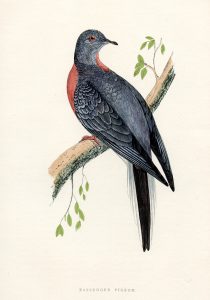REQUIEM, Ectopistes migratorius
September 1–December 13
REQUIEM, Ectopistes migratorius and the Catalog of Extinct Birds
Description of works in the exhibition can be found here.
Full schedule of related programs can be found here
Fall 2014 artist-in-residence Michael Pestel created a multi-media exhibition including an evolving, participatory gallery installation, videos, and collaborative performance works to mark the centennial of the extinction of North America’s Ectopistes migratorius, the passenger pigeon.
A species that once numbered three to five billion birds, the passenger pigeon officially became extinct on September 1, 1914, when the last known pigeon, named Martha, died at the Cincinnati Zoo. Requiem metaphorically places Martha at the center of the installation in the form of a human-scale birdcage, encouraging visitors to contemplate extinction—of the passenger pigeon, of other species, and perhaps even author Elizabeth Kolbert’s The Sixth Extinction, the book selected for incoming first-year students’ summer reading.
The exhibition presents opportunities to discuss such topics as extinction, de-extinction, the history of the environmental movement, the endangered species act, social history and technology’s role in species extinction, ornithology, habitat destruction, art-making, and performance, among others.
Requiem: Ectopistes migratorius and the Catalog of Extinct Birds
Although the passenger pigeon, in general, and Martha, in particular, take center stage in the exhibition, Requiem is framed in the larger context of the Catalog of Extinct Birds. Catalog is an algorithmically generated musical composition accompanied by special instruments designed for its performance. It is based on the current red list of the nearly two hundred avian species eradicated in the six hundred years since the Age of Exploration. Of these species, the demise of the passenger pigeon stands out as the most numerically staggering avian extinction during this and perhaps any time in human history. In this century, the number of extinctions among birds—as well as other families of life—is expected to increase dramatically. Therefore, the Catalog of Extinct Birds, like all such catalogs, will continue to unfold as a perpetual work-in-progress . . . so long as human musicians themselves remain extant.
A species that—perhaps as late as the mid 19th century—numbered three to five billion birds, the passenger pigeon officially became extinct on September 1, 1914, when the last known pigeon, named Martha, died at the Cincinnati Zoo. Requiem metaphorically places Martha at the center of the installation in the form of a human-scale birdcage.
The visually stunning exhibition includes site specific sculptures, videos, meditative performance works, and sound installations that address passenger pigeon extinction. Requiem is also framed in the larger context of Michael Pestel’s Catalog of Extinct Birds. The Catalog is an algorithmically generated musical composition accompanied by special instruments the artist has designed for performance. It is based on the current list of globally extinct birds–nearly two hundred avian species eradicated in the six hundred years since the Age of Exploration. In this century, the number of extinctions among birds—as well as other families of life—is expected to increase dramatically. Therefore, the Catalog of Extinct Birds, will continue to unfold as a perpetual work-in-progress . . . so long as human musicians themselves remain extant.
Thus the exhibition presents opportunities to contemplate a wide range of topics from extinction—of the passenger pigeon, of other species, and author Elizabeth Kolbert’s The Sixth Extinction, the book selected for incoming first-year students’ summer reading—and de-extinction; the history of the environmental movement, the endangered species act, climate change, technology’s role in species extinction, habitat destruction, art-making, and performance, among others.
Visitors are encouraged to become participants through hands-on experiences in the exhibition’s interactive works. Some of the interactions will be incorporated in a performance of Stray Birds, an improvisatory performance by Michael Pestel and Japanese butoh performer Taketeru Kudo, on November 19.
The exhibition is one of many programs, lectures, events participating in Project Passenger Pigeon’s international conversation to promote the conservation of species and habitat, strengthen the relationship between people and nature, and foster the sustainable use of natural resources.
Michael Pestel’s residency is funded by an arts infusion grant made possible by generous support from the Andrew W. Mellon Foundation.
The Lafayette Art Galleries and EPI’s public programs are funded in part with a grant from the Pennsylvania Council on the Arts, a state agency funded by the Commonwealth of Pennsylvania, and the National Endowment for the Arts.

